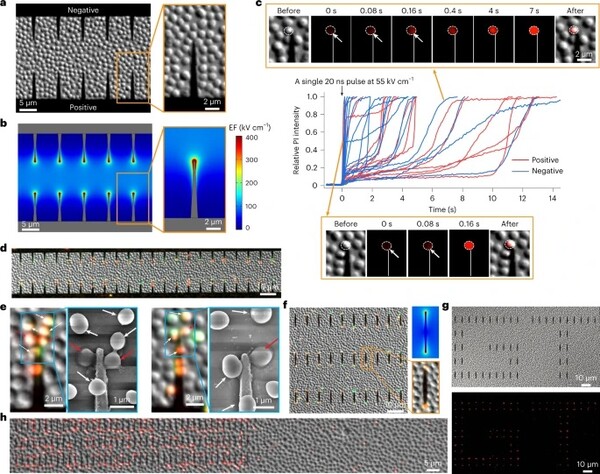조지아공과대 싱시(Xing Xie) 조교수·팅왕(Ting Wang) 연구원 공동연구…『네이처 워터(Nature Water』에 발표
국소적 강화된 전기장((LEFT) 이용 박테리아 멸균…전계 강도 8배 낮추고 처리시간 100만배 단축
![조지아 공과대학(Georgia Institute of Technology) 연구원들은 물을 소독하기 위해 작은 전기 충격을 사용하여 에너지 소비, 비용 및 환경 영향을 줄이는 방법을 발견했다. 이 기술은 전기 그리드(electric grid)에 통합될 수도 있고 심지어 배터리로 구동될 수도 있다. [사진출처(Photo source) = 조지아 공과대학(Georgia Institute of Technology)]](https://cdn.waterjournal.co.kr/news/photo/202302/65688_36670_236.jpg)
안전한 식수를 갖는 것은 공중보건을 위해 필수적이지만, 전통적인 소독방법은 그들 자신의 환경 문제를 야기한다. 염소는 값이 싸고 중앙 집중식 물 시스템에서 사용하기 쉽지만 해로운 화학 부산물을 희생시킨다.
조지아 공과대학(Georgia Institute of Technology) 연구원들은 물을 소독하기 위해 작은 전기 충격을 사용하여 에너지 소비, 비용 및 환경 영향을 줄이는 방법을 발견했다. 이 기술은 전기 그리드(electric grid)에 통합될 수도 있고 심지어 배터리로 구동될 수도 있다.
“이것은 꽤 새로운 소독기술이며, 우리는 먼저 소규모로 시연한 다음 사용 지점 또는 외부 정수를 위한 실제 응용 분야를 개선하고 싶다”라고 싱시(Xing Xie) 칼튼 S. 와일더(arlton S. Wilder) CE(토목환경공학부) 조교수가 말했다.
싱시(Xing Xie)와 그의 박사후 연구원인 팅왕(Ting Wang)은 2023년 1월에 ‘국소적으로 강화된 전기장 처리로 실현된 나노초 박테리아 불활성화(Nanosecond Bacteria Inactivation Realized by Locally Enhanced Electric Field Treatment)’라는 논문을 과학학술지 『네이처 워터(Nature Water』에 발표했다.
![싱시(Xing Xie) 칼튼 S. 와일더(arlton S. Wilder) CE(토목환경공학부) 조교수(오른쪽)와 박사후 연구원인 팅왕(Ting Wang). [사진출처(Photo source) = 조지아 공과대학(Georgia Institute of Technology)]](https://cdn.waterjournal.co.kr/news/photo/202302/65688_36671_326.jpg)
전기 현지화(Localizing Electricity)
기존의 전기장 처리(CEFT ; conventional electric field treatment)가 식품 저온살균에 적용되고 있지만, 상대적으로 높은 비용 때문에 식수 소독에 널리 사용되지는 않았다.
물과 박테리아가 전기에 노출될 때, 박테리아 세포막은 회로의 축전기와 같은 역할을 한다. 일반적으로, 전기장 처리(CEFT)에서 물의 낮은 전도성은 나노초 펄스가 박테리아를 죽일 만큼 충분히 빠르게 막(membrane)을 충전하지 못한다는 것을 의미한다.
연구원들은 박테리아에 직접 전기를 전달하는 국소적으로 강화된 전기장(LEFT ; locally enhanced electric field)을 만들었다. 전극은 전기에 연결되면 즉시 집중된 전하를 축적하는 ‘금 나노팁(gold nanotip)’을 가지고 있어서 전하가 막으로 이동하여 박테리아를 훨씬 더 빨리 죽일 수 있다.
조지아 공과대학(Georgia Institute of Technology) 박사후 연구원인 팅왕(Ting Wang)은 “나노초 펄스(nanosecond pulses)를 사용하는 이 초고속 박테리아 불활성화는 놀라운 일다. 왜냐하면 이론적으로 나노초 펄스가 너무 짧아서 막을 충전하는 데 시간이 걸리기 때문”이라고 말했다.
팅왕(Ting Wang)은 이어 “하지만 국소적으로 강화된 전기장(LEFT)의 나노쐐기(nanowedges)와 나노구조(nanostructures)로 박테리아 세포는 나노금속(nanometal)에 의해 직접 충전될 수 있고, 물을 빠르게 소독할 수 있다”라고 강조했다.
[그림 1] 나노웨지 팁에서 나노초 펄스에 의한 박테리아 활성화

전기 혁신(Electric Innovation)
이 기술을 시험하기 위해, 그들은 칩의 전극 가장자리에 금 나노쐐기(gold nanowedges)를 만들었다. 그리고 나서 그들은 실험실에서 흔히 사용되고 물 시스템에서 종종 발견되는 모델 박테리아인 포도상구균(Staphylococcus)을 칩에 추가했다.
다음으로, 그들은 전기 펄스(electric pulses)를 적용하고 현미경으로 박테리아가 어떻게 반응하는지 실시간으로 관찰했다.
센티미터(cm) 당 40킬로볼트(kv)에서 200나노초(ns) 동안 전기를 가했을 때, 나노쐐기의 95%가 박테리아를 성공적으로 죽였다. 국소적으로 강화된 전기장(LEFT)은 기존 전기장 처리(EFT)와 비교하여 적용된 전계 강도를 8배 낮추고 처리 시간을 100만 배 단축했다.
팅왕(Ting Wang)은 “우리는 나노초의 펄스조차도 다른 상황이 아닌 LEFT의 박테리아를 죽일 수 있다는 것을 발견했다”라고 말했다.
이러한 즉각적인 오염 제거는 물을 소독하는 데 필요한 전기의 양을 감소시켜 이것을 저렴한 위생 옵션으로 만들고 깨끗한 물을 생산하는 것이 환경에 미치는 피해를 줄일 수 있는 미래를 가리킨다.
![싱시(Xing Xie) 조교수가 칩(chip)을 보여주고 있다. [사진출처(Photo source) = 조지아 공과대학(Georgia Institute of Technology)]](https://cdn.waterjournal.co.kr/news/photo/202302/65688_36672_434.jpg)
[원문보기]
New Ultrafast Water Disinfection Method Is More Environmentally Friendly
Having safe drinking water is vital for public health, but traditional methods of disinfection cause their own environmental problems. Chlorine is cheap and easy to use in centralized water systems, but at the expense of harmful chemical byproducts.
Georgia Institute of Technology researchers have found a way to use small shocks of electricity to disinfect water, reducing energy consumption, cost, and environmental impact. The technology could be integrated into the electric grid or even powered by batteries.
“This is a pretty new disinfection technology, and we want to demonstrate in the small scale first, and then improve its real-world applications for point-of-use or off-grid water purification,” said Xing Xie, the Carlton S. Wilder Assistant Professor in the School of Civil and Environmental Engineering.
Xie and his postdoctoral researcher Ting Wang published the paper, “Nanosecond Bacteria Inactivation Realized by Locally Enhanced Electric Field Treatment,” in Nature Water in January.
Localizing Electricity
Although conventional electric field treatment (CEFT) is applied for food pasteurization, it hasn’t been widely used for drinking water disinfection because of the relatively high cost.
When water and bacteria are exposed to electricity, the bacteria cell membrane acts like a capacitor in a circuit. Typically, in CEFT, water’s low conductivity means nanosecond pulses won’t charge the membrane fast enough to kill bacteria.
The researchers created a locally enhanced electric field (LEEFT) that brought the electricity directly to the bacteria. The electrodes have gold nanotips that build up concentrated charges instantly when connected to electricity, enabling the charges to travel to the membrane and kill the bacteria much faster.
“This ultra-fast bacteria inactivation just using the nanosecond pulses is a surprise because, theoretically, nanosecond pulses are just too short to kill the bacteria in conventional electric field treatment because the membrane takes time to charge,” Wang said. “But with LEEFT’s nanowedges and nanostructures, the bacteria cells can be charged directly by the nanometal, quickly disinfecting water.”
Electric Innovation
To test the technology, they fabricated gold nanowedges on the electrode edge of a chip. Then they added model bacteria Staphylococcus to the chip, a commonly used bacteria in labs and often found in water systems. Next, they applied electric pulses and watched how the bacteria reacted in real time under a microscope.
When electricity was applied at 40 kilovolts per centimeter for 200 nanoseconds, 95% of nanowedges successfully killed the bacteria. Compared to conventional EFT, LEEFT lowers applied eclectic field strength by eight times - and shortens the treatment time by 1 million times.
“We found that even nanosecond pulses could kill the bacteria in the LEEFT and not other circumstances,” Wang said. This near-instantaneous decontamination reduces how much electricity is needed to disinfect water, making this an affordable sanitation option and pointing to a future in which producing clean water may take less of a toll on the environment.
[출처=조지아공과대학(Georgia Institute of Technology)
(New Ultrafast Water Disinfection Method Is More Environmentally Friendly | Research (gatech.edu)) / 2023년 2월 20일]
[논문 출처=『네이처 워터(Nature Water』(https://www.nature.com/articles/s44221-022-00003-2)]

